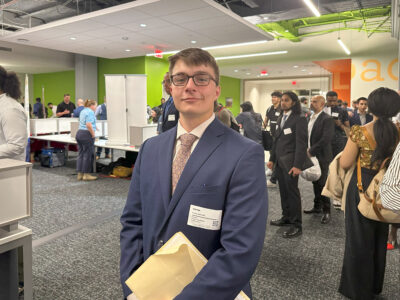While employed by local government’s open data office a few years back, she would often hide away in another department to do deep work. She liked her colleagues and her job, but the busy atmosphere could feel overwhelming — “I was compensating,” she told Technical.ly.
“I knew I had ADHD since I was 26, but I hadn’t been diagnosed autistic yet,” she said. “And when you’re not diagnosed, you have sensory differences, and you learn how to cope or you suffer.”
A commitment to diversity, equity and inclusion work has been on the forefront of companies’ minds in the wake of a social justice movement last summer, but often, DEI work is centered on race and gender.
A focus on these efforts are indeed needed, as people of color and women are systematically excluded in the tech space. But while people operations teams are taking a renewed focus on their practices and policies around inclusion, they ought to also take a look at their practices supporting neurodivergent employees, too.
In myriad ways, neurodivergent people — a term that represents people with neurological types like autism, Attention Deficit Hyperactivity Disorder (ADHD), dyslexia and others — are often excluded from, discriminated against or are forced to operate in workplaces that don’t cater to or support their needs. A Drexel University study found that autistic people are chronically underemployed or unemployed. Nearly 42% of young adults surveyed never worked for pay during their early 20s, and non-white people saw even fewer employment opportunities. It’s estimated that nearly 80% of people with autism don’t have a full-time job.
But the tech industry presents a very real opportunity for many neurodivergent people to thrive. While every person is different, common traits of neurodivergent people include the ability to do deep, technical work and have a strong attention to detail. In 2013, Newtown Square-headquartered SAP launched an Autism at Work program to employ autistic people, and the NYC-based Ultranauts Inc. specifically recruits neurodivergent candidates for software testing and data analytics. About 75% its employees have autism and work remotely for the software consulting company.
We know that neurodivergent people can make great employees, but there are barriers through the recruiting, interviewing and onboarding process that can keep people out of jobs. A reframing of some common processes can greatly impact your ability to hire and support neurodivergent people.
Neurodivergence at work
Ancona, now a program manager for feedback analytics for a federal agency, said although she wasn’t diagnosed with autism until her late 30s, she feels most of the employment decisions she’s made have led her to be surrounded by neurodivergent people. She started her career teaching music, but something about the role felt wrong, and she left shortly after starting the position. Wanting to still work in the arts, Ancona transitioned into marketing for an arts organization, where she fell in love with HTML.
In Philly, Ancona joined coworking community Indy Hall and learned light coding while meeting a bunch of technical folks. At a Code for Philly edtech event, she signed up to volunteer on a visualization of the local school district’s budget, and experienced “a huge career change.”
“People were really supporting my technical self-education, and I was becoming obsessed with open data, and I started learning to make maps,” she said. “Somewhere in that, I got recruited by the City.”
Masking is a tool used by neurodivergent people to blend in in social or work settings to avoid being harassed or discriminated against.
After about two years, she moved onto a role with a federal agency that was remote, but required weekly travel from Philly to DC. It was a rough transition, she said.
The cost of masking — a tool used by neurodivergent people to blend in in social or work settings to avoid being harassed or discriminated against — paired with commuting to DC, working with a lot of different agencies, spending time on crowded trains and in the office there “was too much,” she said.
After what Ancona described as a “meltdown” in a meeting — “looking back now, it was just an emotional statement I made,” she said — she reached out to Dr. Edward Brodkin at the University of Pennsylvania, who works with adults with autism. Her suspicions that she could be autistic were true, she said of her diagnosis in 2019. She was “fully burnt out.”
This work experience is one that many neurodivergent people, and other people with disabilities, have long experienced. The pandemic’s forced adoption of remote work has been a long time coming for many disability advocates.
Marta Rusek, a digital strategist for a voting-focused nonprofit org based out of DC, works remotely from Philadelphia and described some of the “green flags” her employer showed with accommodating her autism. She currently has a flexible start time with work, as she has some disordered sleep issues, and was granted full remote work allowance so she could stay near friends, family and doctors.
Remote work also allows folks more control over their working conditions like noise level, temperature and the ability to take breaks, which can help with overstimulation. The accommodations process can mean cutting through a lot of red tape, and companies should want to help their employees get exactly what they need to succeed. And while it’s especially true for people with disabilities, that sentiment should be true of all workers and their workplaces, Rusek said: Yes, there are some neurodivergent-specific changes that can be made for a more inclusive workplace, but in general, “good companies ask what works best for you.”

Marta Rusek. (Courtesy photo)
Rusek was diagnosed with autism at 30 years old, and in the years since, has fine-tuned her attention to certain red flags. She was let go from a job after disclosing her diagnoses at a 90-day review. She can now spot when she’s being included as “a token interview.” She can spot a toxic workplace from a job description alone.
Other red flags include when a company has no other neurodivergent people on staff, or when job listings include physical labor requirements for unrelated jobs. Job descriptions can also be exclusionary for people with temporary disabilities, like folks recovering from injuries, breastfeeding mothers, or those who have been debilitated by COVID-19.
A huge red flag, in today’s remote world, is when technology a company uses isn’t accessible, Rusek said. There’s no reason captions or ASL can’t be used at virtual and hybrid events, and for people to use accessible language and practices in meetings.
After years of navigating the workforce as an autistic person, Rusek said she’s learned a lot about how she places value on herself and on work.
“I don’t quite fit the pop culture version of autism, although there’s no one look. There are times when I learn who I am all over again,” Rusek said. “When you don’t know something that key about yourself, it’s hard to create an identity. I say that because I’ve reached a point where I don’t give as many fucks as I did when I was younger. You either like what I can do for your company or you don’t.”
What inclusion looks like in practice
For people looking to implement inclusive hiring and employment practices, it shouldn’t be a huge lift to include neurodivergent people.
Philadelphia-based Neurodiversity Employment Network consults companies that wish to employ neurodivergent people on best practices. The org also helps neurodivergent people through the interview process and to succeed in those jobs.
One of the first things companies can do is to re-evaluate their interviews. Some neurodivergent people won’t fit the “neurotypical expectations” or charm aspect of the traditional interview process, said Cait Rosica, the org’s director. Often, hiring managers are looking for folks who will do the job well and fit an existing company culture, but fitting a culture “shouldn’t be a requirement,” said Joseph Riddle, the executive director of Neurodiversity in the Workplace, which works directly with companies in a consulting capacity.
“You can’t create a culture by replicating one type of person, and it’s impossible to control a culture,” he told Technical.ly. “If you build it, they will come. We see a ton of benefit when we highlight neurodivergence, and when we see other talent acquisition people themselves doing so. There’s the ability to build a better company when they are more inclusive.”
Very open-ended interview questions like “tell me about yourself” isn’t the best way to learn about any candidate, he said. You’ll often be presented with an archetype, and what you need to know is likely on their resume. What hiring teams can do, Riddle and other experts Technical.ly talked to agreed, is present a list of topics or questions you’ll be discussing in an interview to the candidate beforehand.
For companies that are looking to hire and support neurodivergent employees, one of the largest impacts you can make is in paying attention to your company’s communication styles, and offering multiple ways to communicate, Riddle said. While one person might thrive in a face to face meeting, another may be better with a written report or a phone call. Offering multiple ways to get the job done ensures it will be completed to the best of the employee’s abilities.
That’ll happen with neurodivergence. https://t.co/RYnZvlIZB5
— auntie cistamine (@laurenancona) December 6, 2021
“My general advice in conversation surrounding accommodations is that we love when people request them, but it’s really just a tool,” Riddle said. “We all give ourselves accommodations every day. Managers should just be looking at what tools they can give their employees, and you don’t need a diagnosis for this to be true.”
Thomas Edwards, Temple University professor and director of the newly established Department of Engineering, Technology and Management, has a doctorate in business administration with a focus on management. When a family member with autism told him about a manager who wasn’t leading him well, Edwards dove into work about supporting neurodivergent employees.
You can watch his full TED Talk, but his main takeaway to those in charge of hiring is to ask neurodivergent people to show you what they can do, versus tell you. It’s especially true of technical roles, where it’s more important that a candidate can show or explain how they’ve tackled past technical challenges than what they feel they “bring to the table.”
And once they’ve landed the job, both the employee and employer should be familiar with the process of requesting accommodations, Edwards said.
From an employee perspective, you can focus your requests on performance, said the prof, framing it as “this is what I need to perform at my maximum.” These requests could range from needing a quiet space to work in, or requesting that they get instructions in a written format. Managers, whose jobs are essentially to make sure each employee can make their contribution, should find a way to make these happen.
https://twitter.com/squishthoughts/status/1470205697979674628
And with each neurodivergent person, the challenging parts of navigating a new job will be different.
Brian Dotsey, who began working at a financial institution handling account issues for clients, worked with Neurodiversity in the Workplace to start his job. The org connected him to two neurodiversity supportive employers that had altered interview processes to support him, he said.
“For me, the main struggle with a new job is just getting used to all the little things that change or the transition between workplaces — how to track time, where to eat lunch, different styles of organization, what colleague is in charge of what task and the like,” Dotsey said. “Most of that is just minor hiccups the job orientations usually try to cover, and I try to mention anywhere the process can be improved. Companies usually don’t mind constructive criticism on new hire processes.”
What does support look like?
A few months after Ancona received her autism diagnosis, she decided to “come out” at work. Although she was shipping all her necessary projects, she’d stepped back from anything that wasn’t strictly related to her role. After 15 years of masking, Ancona was tired.
“I came out at work, because I didn’t know anyone else who was autistic, but even just statistically speaking at an agency with hundreds of employees, I know I was not the only person,” Ancona said.
Women who do get diagnosed often do so later in life, and people of color are even less likely to be diagnosed.
She reached out to her agency’s diversity guild and asked if she could address fellow employees. She gave three talks about what she’d learned about being a neurodivergent person, and how it affected her work. She didn’t come out of the gate with recommendations, but it felt like a good place to start. The goal was to help people to understand her experience.
After those talks, four women — notably, women of color — reached out to her with the recognition that they likely were neurodivergent, too, and hadn’t ever known what autism in women was like. A diagnosis in people assigned female at birth is rarer, because for so long, medical professionals mostly studied the condition in males.
Those who do get diagnosed often do so later in life, and people of color are even less likely to be diagnosed. Morénike Giwa Onaiwu, a scholar and advocate, didn’t get a diagnosis until their young kids were evaluated. The doctors pointed out that their kids had a lot of the same behaviors as Onaiwu and suggested they, too, get evaluated.
“If I had known this, it would have changed so much about the way I behaved, about the way I saw myself, about the way I treated myself,” Onaiwu said in a Facebook Live conversation about how COVID-19 was affecting people with autism. “I hated myself for so long, not being able to do what other people could do, thinking how different I was and how much I hated it. Now I understood there was nothing wrong with me. If I had understood that, I would have gone about life so much differently.”
Inclusion benefits everyone
Two years later, Ancona is now working on starting an employee resource group at her federal agency for neurodivergent employees. She wasn’t sure, at first, that she wanted to take on the work professionally, but a proposal to create the resource group and influence inclusion practices is now a part of her paid role.
Some formal recommendations she makes include making it clear during the interview process that you can request accommodations, and how an employee would do so. It’s also important that a candidate can do an interview remotely, and that employees shouldn’t be forced to have their cameras on during virtual meetings that would highlight physical disabilities, or stimming.
Comfort in an environment has a huge impact on ability to perform.
“Comfort in an environment has a huge impact on ability to perform — control over light or sound, visual stimulation, and also how much access people have to you,” Ancona said. “Also, allocating work blocks or breaks on your own calendar, or having times when people can access you, are formal accommodations.”
One thing that should be clear to people working in this space, or who are aiming to make their workplace more inclusive is that neurodiversity is just that — diverse. Neurodivergent people may not have access to the medical processes of a diagnosis, and both Ancona and Rusek said they are privileged to have been able to afford it.
And neurodivergent people with the same condition will be different from one another. One interview process or work setup that’s ideal for one person might not work well for another. And while some might choose to disclose their diagnosis during an interview, others may never. The point of adding these practices to your company’s repertoire is to make it a more welcoming and comfortable experience for anyone who might apply. Changing your standard of interviewing, onboarding and management with the intention of including neurodivergent people benefits everyone.
“The more people that are allistic-passing, that can take on this work, it would be infinitely more helpful,” Ancona said. “There aren’t enough of us doing this work, and it gives it a lot more credibility, the more people that participate. If you have people in your life who are neurodivergent, or even if you don’t, you can advocate for people in your workplace.”
Before you go...
Please consider supporting Technical.ly to keep our independent journalism strong. Unlike most business-focused media outlets, we don’t have a paywall. Instead, we count on your personal and organizational support.
3 ways to support our work:- Contribute to the Journalism Fund. Charitable giving ensures our information remains free and accessible for residents to discover workforce programs and entrepreneurship pathways. This includes philanthropic grants and individual tax-deductible donations from readers like you.
- Use our Preferred Partners. Our directory of vetted providers offers high-quality recommendations for services our readers need, and each referral supports our journalism.
- Use our services. If you need entrepreneurs and tech leaders to buy your services, are seeking technologists to hire or want more professionals to know about your ecosystem, Technical.ly has the biggest and most engaged audience in the mid-Atlantic. We help companies tell their stories and answer big questions to meet and serve our community.
Join our growing Slack community
Join 5,000 tech professionals and entrepreneurs in our community Slack today!







